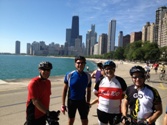| POLICIES AND PROCEDURES
GPS Terminology
Map Sets • Waypoints • GPS
Routes, Tracks, and Courses • Why We Use GPS Tracks Instead of Routes
 Here are the definitions for some common terminology related to GPS technology
and how they specifically relate to incorporating GPS technology into cycling
navigation. Here are the definitions for some common terminology related to GPS technology
and how they specifically relate to incorporating GPS technology into cycling
navigation.
Map Sets
A map set contains specific information about the geographic features
of an area. Different map sets can contain such information as such as cities,
roads, parks, railroads, bodies of water, topography, as well as the names
of these features. Some map sets also contain individual "points
of interest" such as restaurants, gas stations, churches, hotels,
local businesses, hospitals, transportation hubs, etc.
In general, a map set is uploaded into an individual GPS unit and displayed
as the base image for the map that GPS displays. All other user features
(waypoints, tracks, routes, and courses) are displayed overlaid on top of
the map set image.
Waypoints
A "waypoint" is simply a specific, pre-identified location
indicated with a specific indicator overlaid on the map.
All important points on the route, such as rest stops, starting and ending
locations, main lodging sites, and supported hotels will be indicated with
a waypoint.
GPS Routes, Tracks, and Courses
While the terms "tracks", "routes", and "courses" can
generally be used interchangeably in common everyday language, there are
very important differences between them when it comes to GPS terminology.
Routes
A GPS "route" is the path a GPS unit automatically calculates
between two (or more) defined points based on different specified criteria.
Routes are appropriate when the specific path you take to get somewhere does
not matter, and most GPS units used in cars operate by following automatically
calculated routes between two specific points (usually your current location
and the destination). Some different route calculation criteria include shortest
distance vs. least amount of time, major highways vs. minor roads, and avoiding
toll roads, unpaved roads, carpool lanes, and u-turns.
Routes will vary greatly depending on the criteria specified and the further
away the starting and ending points. For example, if you wanted to travel
from Seattle to Miami there are many ways to do so, depending on whether
you wanted to primarily follow interstate highways, state and US highways,
residential roads, or paths and trails. Your travel preferences would define
the specific criteria against which the GPS unit would calculate the route.
An important consideration about routes is that GPS units will only calculate
a route following roads or paths within its loaded map set data. So if a
bike path is not contained within the map set, it could not route you onto
it, and unfortunately most bike paths are not contained within most GPS map
sets. Because routes follow roads with the map set, the GPS unit can provide
you turn by turn directions and indicate or "tell" you when to
turn, such as a beep, having a box flash up, some lady's voice saying
"right turn in half a mile".
Tracks
A GPS "track" is a series of individual points connected in a
line, and each individual "point" is a specific location defined
by a latitude and longitude coordinate. Tracks are also called "breadcrumb" routes
because they resemble the fairy tale about leaving a trail of breadcrumbs
along the way you travelled in order to find your way back.
Because the points that make up tracks are absolutely defined by specific
latitude and longitude coordinates, tracks will never vary. They are not
automatically calculated by any GPS unit or software and do not rely on the
presence of any map set information (such as road names). Accordingly, turn
by turn directions do not automatically come up or beep when you are following
a track. To properly follow a track you simply have to make sure that your
location indicator is on top of the indicated track at all times.
All of the cycling routes we follow are defined by tracks, and every one
of the points within every track were taken by us in person actually on the
road. The GPS units we use to take track points also collect time and elevation
data with each point, and we use this data to directly generate all of our
elevation and gross climb data and profiles.
Courses
A GPS "course" is actually a route that is automatically created
from the data points in a preexisting track. Courses combine the best features
of both tracks and routes because they allow on screen turn by turn navigation
while still maintaining a path that is absolutely defined and does not vary.
Unfortunately courses are only currently used in the Garmin Edge 800 units.
While this is an exciting capability and we look forward to course capability
being incorporated into other GPS units as technology progresses, unfortunately
we cannot provide Edge 800 units to our participants for navigation purposes
because they cannot be quickly or easily charged on the road in case they
run out of power.
- Click Here for more information on GPS Unit Power.
Why We Use GPS Tracks Instead of Routes
We must provide the safest possible route for our participants to follow,
and it is absolutely critical that all participants follow our predetermined,
published routed at all times for both logistic and safety reasons. Therefore
we use must tracks to define our cycling routes instead of routes because
they do not vary. If we followed automatically calculated routes it would
be impossible to ensure that all participants would be following our predetermined
routes at all times. In addition, bike paths are generally not included in
map set data so it would be impossible to have our route follow bike paths
at any time if using routes.
- Click Here for more information about Following the Route.
- Click Here for
more information about Intentional Route Deviations.
|

